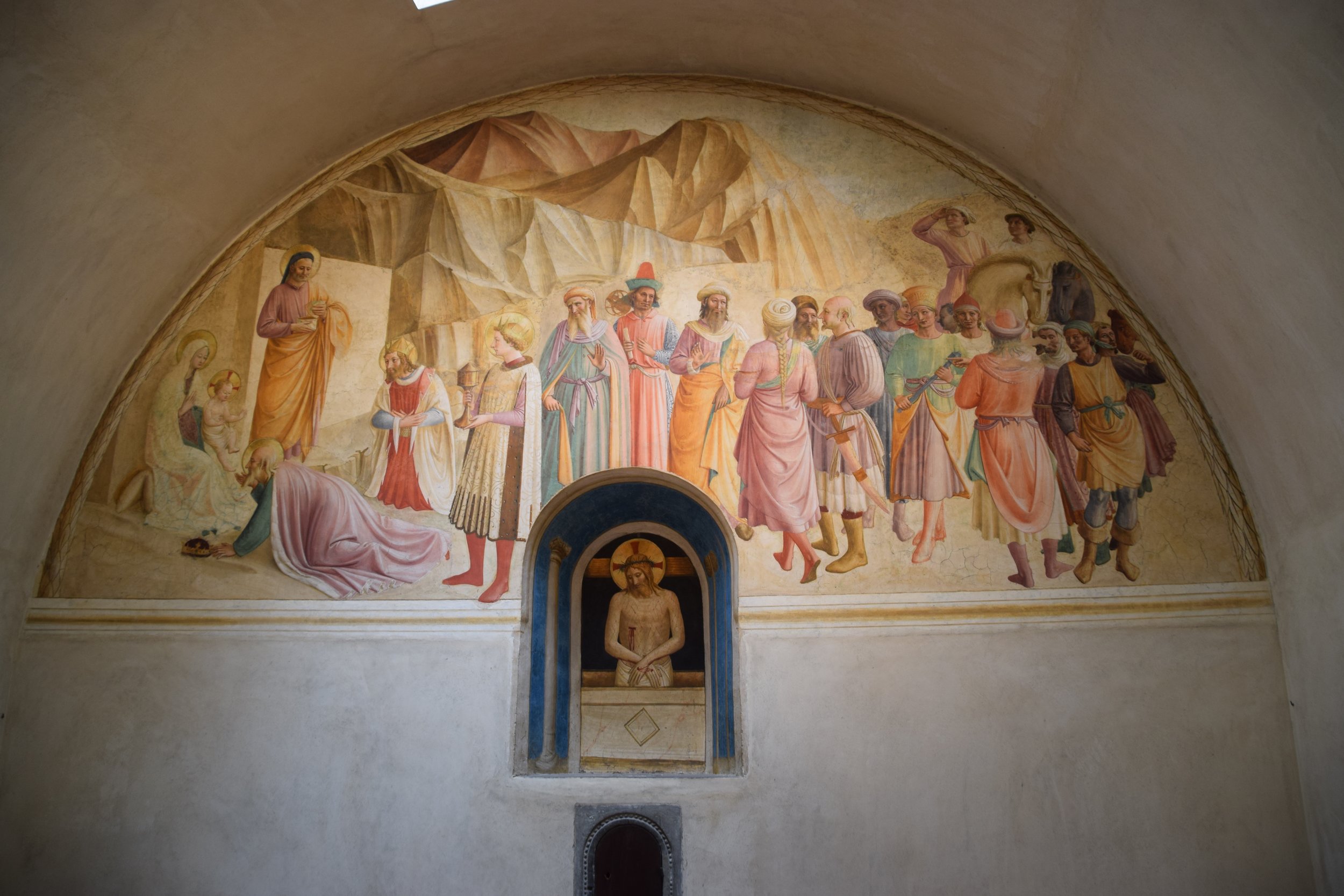
Page 200: San Marco chapter house pelican
... an image of the pelican is found in the painted border above Fra Angelico’s frescoed Crucifixion in the chapter house of the Dominican Monastery San Marco in Florence.

Page 200: Santa Croce refectory pelican
Across town in the refectory of the Franciscan church of Santa Croce, the pelican has built her nest on top of the cross itself.

Page 200: Santa Croce sacristy pelican
The same image is found in the border above the Crucifixion in the sacristy. And in the border immediately below the cross? A small image of the Sacrifice of Isaac.

Page 211: Dominican friars in the frescoes illustrating postures of prayer
Tropological devotion in these scenes is highlighted even further by the regular inclusion of a Dominican friar meditating inside the scene itself as a sort of model for the friar in the cell. (William Hood is the chief scholar who has shown that this corridor of the dormitory was occupied by the novice friars, and that the gestures of the Dominican friars painted below the crucifix illustrate the positions of prayer in a treatise of prayer attributed to Saint Dominic.)

Page 211: Another posture of prayer modeled by the friar in the painting

Page 211: Another posture of meditation and prayer

Page 211-212: Cosimo de Medici's cell with fresco of the Adoration of the Magi
Frescoed on the wall of the inner room is the Adoration of the Magi, set in a simple rugged desert landscape, a scene in stark contrast with the exotic countryside frescoed on the walls of the family chapel in their palazzo down the street, where the Magi, splendidly dressed and accompanied by an enormous entourage, process ceremonially around the walls.

Page 212: The anteroom to Cosimo's cell in Monastery San Marco
Except that the painter Fra Angelico has made a name-change in the gold halos. Instead of “John,” the writing around the halo of the beloved disciple is “Cosmas,” Cosimo.

Page 212: Legend of the Holy Cross, scene of the Finding of the Cross (Piero della Francesca)
In the scene from the Legend of the Holy Cross where Empress Helena watches as the three crosses are dug up, the city depicted by Piero della Francesca in the background must be identified (in the story) as Jerusalem—but it clearly represents contemporary Arezzo

Page 215: Scene of the Approval of the Rule, Sassetti Chapel (Ghirlandaio)
No one could not have noticed the presence of Mr. Sassetti’s boss and patron, Lorenzo de Medici, standing at Sassetti’s side in the scene of the Approval of the Rule of St. Francis, or, even more visually peculiar, the presence of the sons of Lorenzo ascending a staircase with their tutor Angelo Poliziano in the very foreground.

Page 215: Healing of the lame man and Raising of Tabitha, Brancacci Chapel (Masaccio)
Another possibility is to understand this painting—or Masaccio’s painting of the two well-dressed men strolling between the healed crippled man and the resurrected cloth maker—as a sort of moral litmus test for anyone looking at it.

Page 217: Façade of the cathedral of Siena, the Crowning of the Virgin (in mosaic)
The mosaic scene in the highest pinnacle of the façade of the Duomo in Siena depicts the Coronation of the Virgin.

Page 217: Façade of the cathedral in Orvieto, the Crowning of the Virgin (mosaic)
In the Orvieto Duomo, also dedicated to the Virgin, the same upward movement towards Mary’s Crowning is exhibited in both the mosaics on the façade and in the fresco cycle in the apse behind the altar.

Page 217: Scenes from the life of Mary in the cathedral of Orvieto
The scenes on the East wall, directly behind the altar, present in upward movement the Angel announcing to Mary her impending death; the death of Mary; the apostles taking the Virgin to her sepulcher; Christ awakening Mary and taking her to heaven; Mary elevated to heaven in the presence of the disciples; the Assumption of Mary under the central arch, and her Coronation in the vaulting above.

Page 218: Ceiling in the Baptistry of Florence (mosaic)
The narratives-in-mosaic in the ceiling of the Florence Baptistry—stories from Genesis, of Joseph in Egypt, of the life of Christ—revolve around the focal point of the Last Judgment high above the altar on the East side.

Page 218: Last Judgment in the Baptistry of Florence
The narratives-in-mosaic in the ceiling of the Florence Baptistry ... revolve around the focal point of the Last Judgment high above the altar on the East side.

Page 218: Last Judgment on the façade of the Orvieto Duomo
The grand narrative of salvation that stretches from left to right across the four panels on the façade of the Orvieto Duomo begins with the Creation and Fall. The second and third panels, framing the central portal, present the prophecies of a coming Messiah and the life of that Incarnate One from the Annunciation of his birth to his Resurrection. The fourth panel concludes the story with the Last Judgment.
















